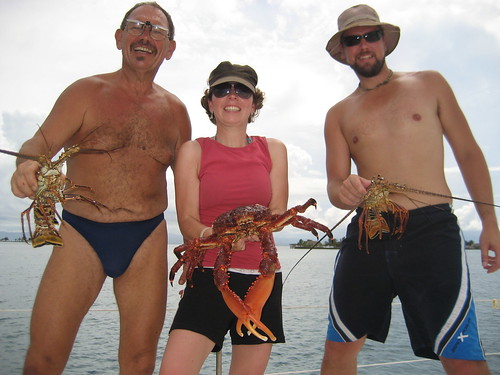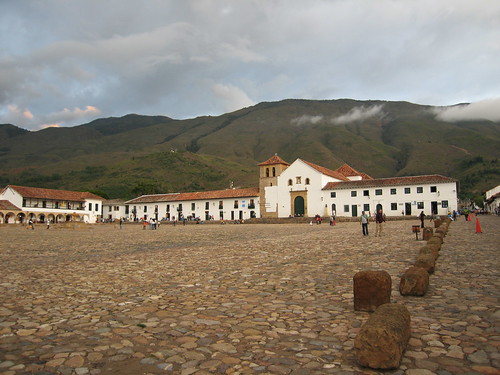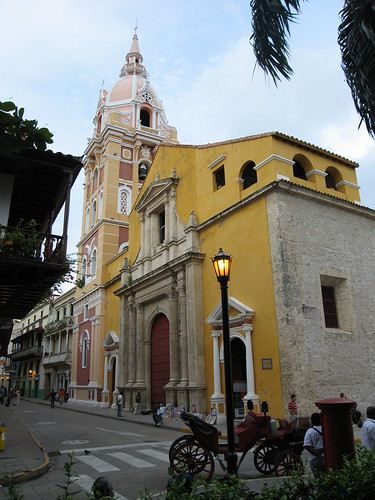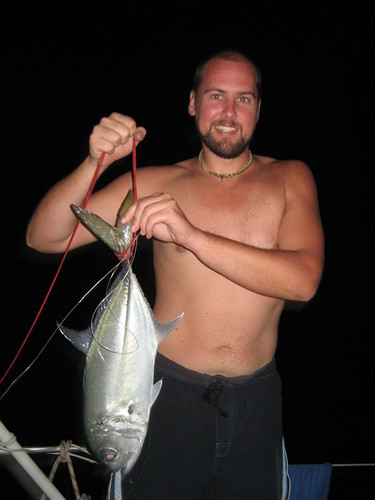Check out Colombia
:: Parade in Cartegena ::
A long day's travelling brought us to the city of Cuenca, third largest city in Ecuador and the official home of the Panama hat. We stayed in a hotel overlooking the market, unfortunately the market square was being renovated so it was a building site. It didn't stop the hotel owner from saying that the room still had a great view of the work in progress and we should come back next year for even more of a spectacle. This year it's all JCBs and noise. One of the most unusual things about Cuenca was the morning protein drink of the menfolk. Namely a beer with a raw egg thrown in, it was on sale and being consumed everywhere. After a rainy day in Cuenca stooging around we moved on to the town of Banos up in the highlands.
All memories of Banos revolve around the news that Marcus's sister Maija gave birth to a baby girl, Raina. In celebration we climbed the big hill behind town. The following day we headed for the capital Quito where we threw ourselves into a couple of busy days sightseeing. Unfortunately we left it too late to try skewered whole guinea pig, the delicacy was no where to be found. As the weather became dreary and the rain showers continued at high altitude we began to look forward to moving north towards Colombia's tropical temperatures.
Colombia is a country once synonymous with cocaine, kidnapping, violence and guns. Its tainted reputation means most people associate it with danger. It's an unlikely runner on most people's top ten places to visit. We crossed into Colombia with an open mind and a heightened sense of vigilance. Any nervousness rapidly disappeared as we progressed through the country. In fact the Colombia tourist board embrace this negative misconception and uses it to their advantage, they are currently running a campaign to promote tourism, the TV ads showcases the sites, natural beauty and people of Colombia and the slogan is "Colombia..... the only risk is wanting to stay".
Our first stop was the town of Pasto a few kilometres inside the border. Thankfully we felt like chicken for dinner because there was very little else to eat there. From there we bussed north through stunning scenery to the city of Popayan. Surprisingly Popayan turned out to be a very non-touristy place despite having perfect cobblestones streets, white washed houses and fancy lanterns. It was just an ordinary town with an extraordinary air of pride about it. Beautiful buildings housed normal everyday businesses.Travelling north through the city of Cali we made it to Bogota, a city of horrendous statistics. Allegedly 1 in 5 people in Bogota statistically have a gun, and that's ones that are licensed, the unofficial number is even higher. We found Bogota to be a great city, it has a heavy helpful police presence but overall it has a great vibe. It's old town is a funky area full of bars and restaurants. Budget accommodation options are limited and fill up quickly, if you're not following a guidebook's sanitised accommodation list then you'll typically be asked how long you want the room for. Expected answer is in hours as opposed to days. It sounds seedier than it actually is, it's simply the way things work in this neck of the woods.
We took some time out to visit the police museum, a large portion is dedicated to the successful tracking and capturing of the infamous drug cartel head Pablo Escobar. It was a good museum and our young police guide did his best to answer all fielded questions - although there really was no good answer as to why the supply of cocaine from Colombia has remained unaffected despite the busts and what FARC does out in the jungle with all revenue collected from the multi million business. Pablo Escobar and old style cartels may have died a death but in essence the problem still remains, just in another form.
Scooting through Bucaramanga we reached the picture perfect town of Villa de Leyva, a place where time truly has stood still. There's virtually no modern architecture just old cobblestone streets, whitewashed buildings and doorways and window shutters with dark green shutters. The centre of town, the Plaza Mayor is a huge square fringed by the town Church, restaurants and bars. It's easy to explore the whole town in an afternoon, and you find yourself wondering how they manage to keep it so preserved and devoid of modern trappings.
We kept heading North until we reached the Caribbean and the important milestone of the top of South America in the coastal city of Santa Marta. A combination of heat, humidity, sunshine, colourful street markets and a distinctively more Caribbean looking population made it feel like we'd crossed into a new exciting country. New street food, interesting looking thirst quenching drinks and the appearance of plantains and frijoles (refried beans) with every meal was a clear indication that although we were still in Colombia it was a very different Colombia.
Our final stop was the old city of Cartagena, undoubtedly one of the most beautiful cities we've been through. It's described as the jewel of the Caribbean and it's no understatement , it's a very well kept secret. There are two distinctive sides to Cartagena, the ugly modern high rise city and, at a very sensible distance away, the old preserved quarter. Part of the city's beauty is that one doesn't spill into the other and spoil it. Perched on the coast the old colonial old city and fortress dominates the landscape. Inside the old wall, streets upon streets of brightly painted houses support vibrantly coloured bougainvillea plants. Part of the old town is dedicated to swish upmarket restaurants, pedestrian plazas, shops and boutique hotels but you don't have to go far before you stumble upon the more locally orientated businesses. The fact that it's not a cordoned off touristy area devoid of real life adds to its charm. Our few days there hold nothing but good memories, we wandered around the old town and harbour, found a lunch stop that churned out great fresh fish daily and we watched what seemed like constant parades and festivities. An ongoing time consuming task was finding a way out of Colombia and on to Panama.
The challenge of completing our journey overland gets a little trickier when crossing from South America into Central America simply because no road exists between the two. The area around the border is known as the Darien Gap, currently covered in dense jungle and apparently full of drug runners and guerrillas. Not a particularly attractive piece of land to hike through. The other option is to sail around the problem from Cartagena to the San Blas islands in Panama. There are a few European and American captains bobbing around the Caribbean on their yachts who take backpackers between the two points. To catch a boat it is a matter of finding out who was in port and when they were planning on to leave. Of course, it's also a matter of finding a good boat and a competent captain for the five day trip. We bumped into a group of travellers who had made the journey vice versa from Panama, half had a great trip the other half had had a miserable five days being thrown around in a tiny boat amidst big waves. We sniffed out the "great" trip and hooked up with Fritz-the-Cat a 50ft catamaran captained by an Austrian, Fritz. From the outset everything bode well, the boat was only carrying half its usual passenger capacity so we all got cabins. Normally the cat carries twelve people plus captain on the journey. With only six passengers/crew on our crossing there was more than enough room.
Our cruise through the Caribbean got off to a slow start - we spent the first day stuck in the harbour waiting for our passports to be returned by port authorities with exit stamps. Waters in the harbour were flat and gentle so naturally everyone was feeling great - all set for the voyage. We eventually got the go ahead that all the paperwork has been completed, we pulled up anchor and sailed for the open seas, narrowly missing an unlit buoy on the way out. About an hour later half the people on the boat were stuck down by severe seasickness as we ventured out into the rougher, choppier waters. One of the advantages of the catamaran is its stability in the water. We can only imagine how much more violent the trip would be on a smaller yacht.
Part of the deal when you catch one of these yachts is that you help out crewing for the journey. So for the three members not effected by seasickness the first night consisted of long stints on watch. Autopilot kept us on course but torrential rain and winds meant that we had to be on the lookout for anything around us that we could potentially collide with. On day two things deteriorated, the weather improved but midway through the day the autopilot decided to die so the remainder of the journey in the open seas (24 hours) had to be steered manually. Sailing a straight course manually is not easy at all, constant correction and concentration is required. Even then it's almost impossible not produce a zigzag pattern on the GPS map. We came to really appreciate the value of autopilot and just how precise it is. By the second night the seasickness still hadn't abated and half the crew were on deck moaning and generally feeling rotten. The autopilot was still on the blink so tired eyes manually steered the course (with some mad off course portions).
Day three brought the end of the open seas, all of a sudden the water grew calm and bath like as we glided into new territory, the San Blas island archipelago - small little Robinson Crusoe islands complete with deserted white beaches and palm trees. All sickness and associated bad memories disappeared and for the next two days we swan, snorkeled and fished - successfully may I add, Marcus caught a baby shark on his first go followed by a mackerel that fed the boat. Each day Fritz would grab a couple of lobsters from under a rock and we'd have them for dinner. Locals from the area came by selling monster crabs and lobsters..... we were spoiled by top of the shelf gourmet seafood. Fritz turned out to be an ex-restaurateur and chef so each morning we woke up to the smell of freshly baked brown bread and hungrily looked forward to every meal.

:: Captain Fritz....and lunch ::
We technically reached Panama by swimming from the boat to the shore of a little paradise island, a novel entry into a country. Officially we entered the following day. Saying goodbye to Fritz and the catamaran we stepped ashore and crowded into jeeps destined for Panama City. We were left with more than memories of our Caribbean cruise, it took a full three days for the ground to finally stop swaying underneath us.
:: San Blas vista ::






0 comments:
Post a Comment